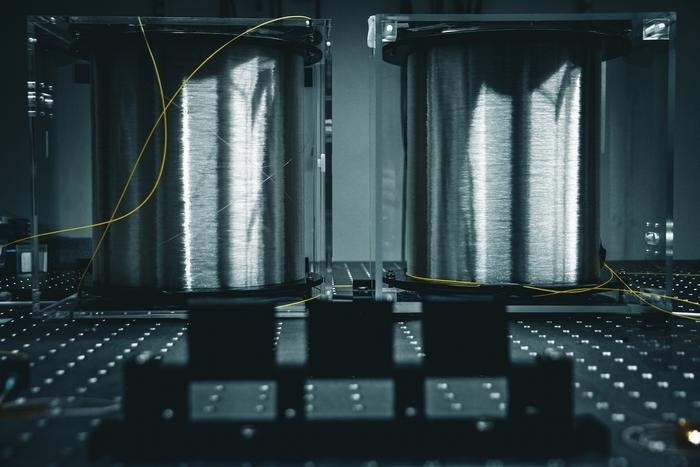Reviewed by Lexie CornerApr 3 2024
Researchers at DTU have achieved the distribution of a quantum-secure key through “Continuous Variable Quantum Key Distribution (CV QKD).” This method has been successfully extended over a groundbreaking distance of 100 km, marking the longest distance ever attained using CV QKD. An advantage of this method lies in its compatibility with the current Internet infrastructure.
 The 100-km fiber optic cable through which a team of researchers at DTU has successfully distributed a quantum-encrypted key securely. Image Credit: Technical University of Denmark
The 100-km fiber optic cable through which a team of researchers at DTU has successfully distributed a quantum-encrypted key securely. Image Credit: Technical University of Denmark
Quantum computers threaten algorithm-based encryptions that protect data transfers from monitoring and eavesdropping. They are not currently strong enough to break them; however, it will happen eventually. All data connected to the internet is vulnerable if a quantum computer manages to decipher the safest algorithms. This has sped up the creation of a novel encryption technique based on quantum physics.
However, maintaining consistency over greater distances is one of the difficulties presented by quantum mechanics that researchers must overcome to succeed. So far, short-range continuous variable quantum key distribution has proven most effective.
We have achieved a wide range of improvements, especially regarding the loss of photons along the way. In this experiment, published in Science Advances, we securely distributed a quantum-encrypted key 100 km via fiber optic cable. This is a record distance with this method.
Tobias Gehring, Associate Professor, Technical University of Denmark
Gehring, alongside a team of researchers at DTU, strives to enable the global distribution of quantum-encrypted information through the internet.
Secret Keys from Quantum States of Light
Data must be protected when sent from point A to point B. For the sender and the recipient to access the data, encryption combines the data with a secure key shared between them. The encryption will be compromised if a third party manages to decipher the key while it is being transmitted. Thus, key exchange is necessary for data encryption.
Researchers are developing cutting-edge quantum key distribution (QKD) technology for important exchanges. The method uses light from photons, which are quantum mechanical particles, to ensure the exchange of cryptographic keys.
The quantum mechanical characteristics of photons are used by a sender, transmitting information encoded in them to generate a unique key shared by the sender and the recipient. Photons in a quantum state can be instantly changed from their original state by others attempting to measure or observe them. Consequently, the only way to measure light physically is to interfere with the signal.
It is impossible to make a copy of a quantum state, as when making a copy of an A4 sheet - if you try, it will be an inferior copy. That’s what ensures that it is not possible to copy the key. This can protect critical infrastructure such as health records and the financial sector from being hacked.
Tobias Gehring, Associate Professor, Technical University of Denmark
Works via Existing Infrastructure
It is possible to incorporate Continuous Variable Quantum Key Distribution (CV QKD) technology into the current internet framework.
Tobias Gehring says, “The advantage of using this technology is that we can build a system that resembles what optical communication already relies on.”
Optical communication is the internet’s backbone. It transmits data through optical fibers using infrared light. They serve as light guides inserted into cables so that data can be sent anywhere in the world. Fiber optic cables allow data to be sent more quickly and over longer distances, and light signals are less prone to interference (technically known as noise).
It is a standard technology that has been used for a long time. So, you don't need to invent anything new to be able to use it to distribute quantum keys, and it can make implementation significantly cheaper. And we can operate at room temperature. But CV QKD technology works best over shorter distances. Our task is to increase the distance. And the 100 km is a big step in the right direction.
Tobias Gehring, Associate Professor, Technical University of Denmark
Noise, Errors, and Assistance from Machine Learning
The researchers achieved an extended distance by addressing three limiting factors that hindered their system from exchanging quantum-encrypted keys over longer distances.
Machine learning facilitated earlier detection of disturbances, termed noise, affecting the system. These disturbances, which may originate from sources like electromagnetic radiation, have the potential to distort or compromise the quantum states being transmitted. Early noise detection enabled more efficient mitigation of its effects.
The researchers are now more adept at fixing mistakes that may arise along the route due to interference, noise, or hardware flaws.
Tobias Gehring says, “In our upcoming work, we will use the technology to establish a secure communication network between Danish ministries to secure their communication. We will also attempt to generate secret keys between, for example, Copenhagen and Odense to enable companies with branches in both cities to establish quantum-safe communication.”
Journal Reference:
Adnan, A. E. H., et al. (2024). Long-distance continuous-variable quantum key distribution over 100-km fiber with local local oscillator. Science Advances. doi.org/10.1126/sciadv.adi9474.